Socio-economic transformation of Russian society
Автор: Perova Margarita Borisovna, Perov Evgeniy Viktorovich
Журнал: Economic and Social Changes: Facts, Trends, Forecast @volnc-esc-en
Рубрика: Development strategy
Статья в выпуске: 4 (22) т.5, 2012 года.
Бесплатный доступ
There are radical changes in Russia, which cover all the aspects of public life. They cause problems in the society and provoke conflicts in various spheres of public life. The key moment that raises tension in the society is a population living standard. In the political system there is a transformation of property institution, public living conditions and socio-political structure of the society. These changes have entailed the evolution of population mentality. The analysis and management of transformation process in all the systems allows to reduce social tension.
Transformation, living standard, socio-political system, population mentality
Короткий адрес: https://sciup.org/147223373
IDR: 147223373 | УДК: 316.42:330.59(470)
Текст научной статьи Socio-economic transformation of Russian society
Creating a stable state requires an analysis of changes in society. Radical changes have taken place in all the spheres of social life at the turn of the millennium in Russia. The transformation of the economic system has led to the changes in the socio-political system, as well as in the population mentality and society at large. The analysis and management of transformation in all the systems can reduce the social tension that promotes conflicts in various spheres of society’s life activity.
Transformation of the economic system
The transition to a market economy was proclaimed as a target of the radical trans- formation of the economic system at the beginning of perestroika. In this process the state should champion the ideas of liberalization, privatization and macroeconomic stabilization. As a result, Russia was awarded the status of a market-economy country in 2002. However, achieving this goal in the initial stage of perestroika was followed by a decrease in production volumes and falling living standards of most people (table).
The recovery period began in 1999, and it lasted until the beginning of the financial crisis in 2008. The amount of pre-reform GDP (102% to the level of 1989) was made in 2007.
Dynamics rates of Russia’s macroeconomic indicators*
Indicates in fixed prices Dynamics rates: the end of 1998 to1991, % Gross domestic product 60.5 Industrial production 48.2 - extractive 67.2 - manufacturing 40.7 The amount of the executed construction works 31.0 All transport freight turnover 57.4 Agricultural production 50.7 Investment in fixed assets 24.8 Real disposable population incomes 52.5 * Official site of the Federal State Statistics Service. Available at:
Real disposable incomes exceeded the level of 1991 by 9.8%. The production volumes of extractive industries accounted for 103.1% in relation to 1991. At the same time, the production volumes of manufacturing and agricultural sectors accounted for only 3/4 of the 1991 level (77.4 and 75.5% respectively). Investments in fixed assets decreased 2-fold as compared with1990 (56.6%). There was a significant lag in the machinery and equipment production (55.8% in relation to 1991).
It is a general situation. The dynamics of the main indicators of living standards is more interesting because it is a key factor that increases social tensions. Among the indices that reflect the living standard of population it is possible to point out such indicators as gross domestic product per capita in fixed prices, per capita population incomes, gross average monthly wages in comparable terms, the share of people with incomes below the subsistence level, a consumer price index for goods and services to the population, an unemployment rate.
GDP per capita is one of the main indicators of the country, determining the population living standard: income, health care, education, etc. The GDP size per capita shows the population living standard even more precisely through purchasing power parity (the value of all the final goods and services estimated at U.S. dollars in 2005).
Analyzing the dynamics of this indicator1 for the period from 1993 to 2010, we can see that it decreased to 1998 inclusive in the early period (by 4.9% per year on an average). Then it steadily increased until the financial crisis in 2008; an average annual growth rate was 7.3% (fig. 1) . The financial crisis caused a drop in production and per capita GDP. Per capita GDP reduced by 7.8% in 2009 alone. However, it increased by 4% during the following year and slightly exceeded the level of 2007.
Average per capita population incomes. The main sources of income are:
-
> factor incomes: wages, income from property (rent, interest, dividends), entrepreneurial income (profit);
-
> transfer payments: pensions, benefits, scholarships, etc.;
-
> other incomes: insurance indemnity, foreign exchange proceeds, etc.
Average per capita population incomes in current prices steadily increased2. They grew 417-fold over the analyzed period, increasing annually by 42.6% on an average (fig. 2) .
However, population incomes in current prices do not reflect their purchasing power. Real incomes of population are reflected clearly by an average wage index in hard currency.
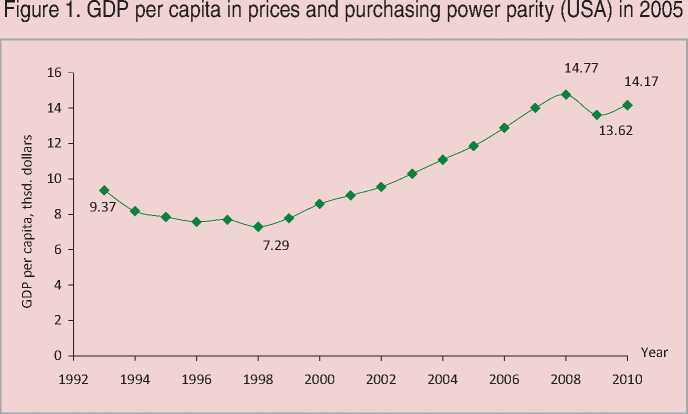
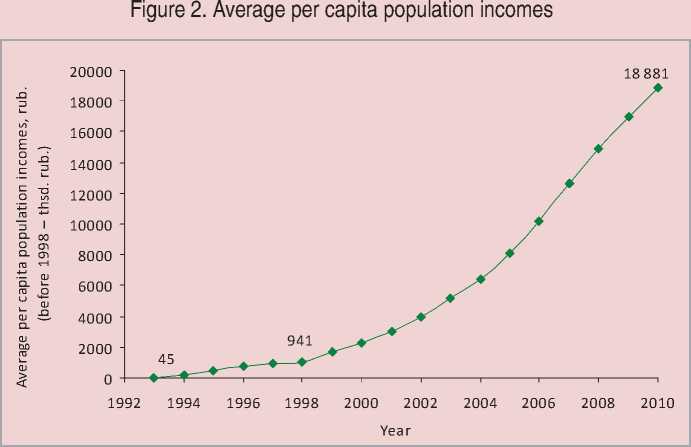
Average monthly wage in hard currency (U.S. dollars) . Gross average monthly wage includes the total amount of wage in money term and in kind before tax deductions and social security contributions.
The dynamics of population incomes in hard currency (fig. 3) differs from the dynamics of income that is shown in figure 2. The average monthly wage increased in 1993 – 1997: it was 2.8 times higher at the end of the period than it was in 19933.
Then the average monthly wage was decreasing for 2 years because of the financial and economic crisis in 1998 (the default).
In 1999 the level of average monthly wage in hard currency was only 38% of the 1997 level. This index has been growing since 2000. The average monthly wage had increased by 11 times over the next few years before the financial crisis began in 2008.
There was a real population income increase against the background of sustainable economic growth.
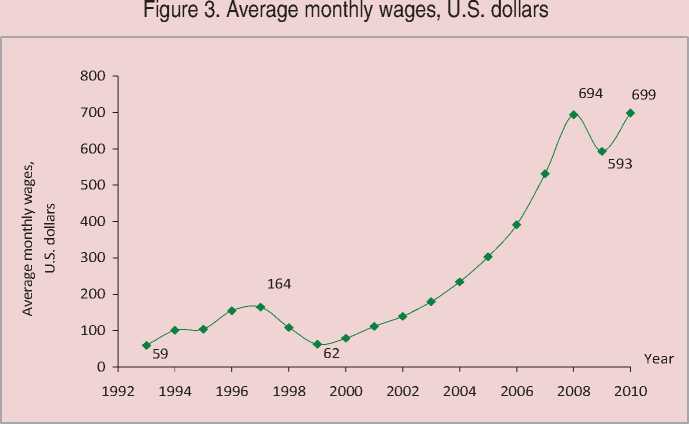
The share of people with incomes below the subsistence level . Poverty is recognized as a global problem. There is no generally accepted method of determining a poverty level because the economic development level of different countries is diverse and uneven. The poverty rate is determined based on the minimum wage rate in most European countries. A typical European is considered poor if his/her income level is below 60% of the average wage. According to the UN methodology, a person can be called poor if his/her income level is $ 2 per day, and the people, who earn only $ 1 per day, are considered extremely poor. In Russia a person is recognized as poor, if his/ her monthly income is less than the subsistence level, which is set by the Government on the basis of consumer goods basket cost.
As a rule, non-adapted citizens, unemployed people and immigrants with many children come under the heading of the poor in the West. In Russia disabled persons and pensioners are also included in this category. The peculiarity of Russia is the fact that more than 60% of the poor population is employed, i.e. the wages of these people do not cover the cost of consumer basket. It is important that highly skilled professionals (doctors, engineers, scientists) also lived below the poverty line, especially in the early years of perestroika. This erodes the middle class, which serves as the foundation of social stability.
The incomes of a third of the population (46.1 million pers.) were below the subsistence level in 1993 (fig. 4) . Then, these figures decreased until 1998 and dropped down to 21%4. The poverty rate rose again after the default in 1998 and accounted for 29% (41.6 million persons in 1999; 42.3 million persons in 2000). There was a steady decrease of this indicator in subsequent years. The poverty rate was equal to 12.6% (17.9 million) in 2010.
However, it should be remembered that the calculated poverty headcount depends not only on poor’s income but also on the size of the consumer goods basket. Changing the set of products that are included in the consumer goods basket or reducing consumption rates also leads to the changes in the poverty headcount.
Consumer price index for goods and services is a key indicator of an inflation rate. It reflects the dynamics in the cost of consumer goods and services basket, changes in the cost of living in the country; it is an early indicator of consumer inflation and changes in the purchasing power of national currency.
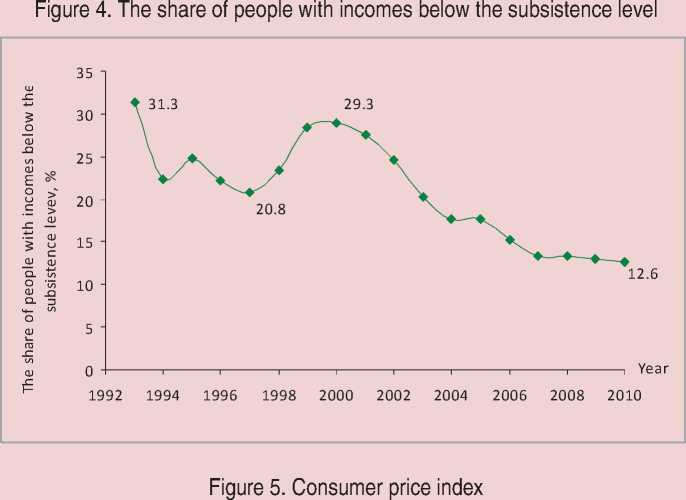
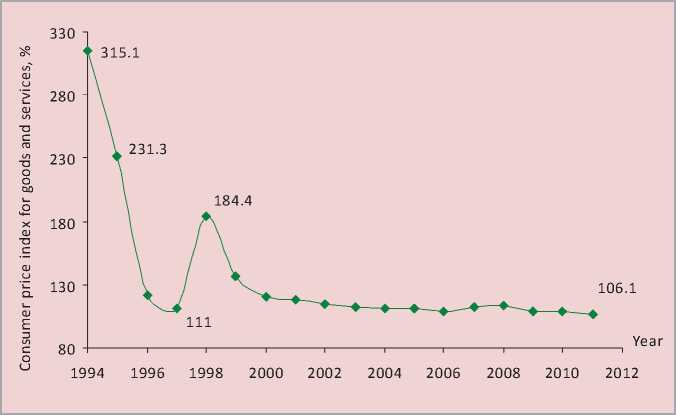
The liberalization of prices for consumer goods and services caused hyper-inflation in 1992, when prices increased by hundred times a year. There was a 26 –fold increase in the prices for consumer goods and services in 19925. The consumer price index was 940% in 1993 and 315% in 1994 (fig. 5) .
The rapid rise in prices led to the distortion of commodity-money circulation that was often replaced by barter. Liquid goods, whose intrinsic value did not depend on the government policy, especially freely convertible currency, began to be used as the equivalent of money. Monetary system degradation, devaluation of savings and debenture bonds caused the greater economic decline.
The inflation rate was reduced in the following years, but it remained rampant: 231% in 1995 and 111% in 1996. The financial crisis of 1998 provoked another rise in prices. The risks associated with nominal prices contracting were high under the runaway inflation, so freely convertible currency was still used often. High inflation rates influenced the behavior of households and firms; inflationary expectations were very important. Any price increase led to wage-push and cost escalation.
Economic growth and GDP growth per capita helped to reduce the consumer price index since 1998. It had been decreasing since 2000, remaining within 120-106%. The consumer price index increased by 2.9 p.p. only in 2007 and by 1.4 p.p. in 2008.
An unemployment rate shows the share of unemployed persons in the total number of employed people or in the number of the population group. Unemployment leads to the loss of revenue, it causes mental health problems, loss of skills, worsening of the crime situation and increasing social tension.
In the analyzed period, the unemployment rate increased till 1998 (13.2%, 8.9 million persons); it grew by 2.3 times over that period6. Since 1999 the unemployment rate had been steadily declining till 2007 when it accounted for 6.1% (fig. 6) . The unemployment rate increased slightly (by 2.3 p.p.) during the financial crisis, while it was still below the 1998 level.
Thus, there are three obvious periods in the transformation of the economic system:
-
♦ 1993 — 1998: the period is characterized by economic downswing, reducing the volume of per capita GDP, increase of a poverty rate, rising unemployment and high inflation rates;
-
♦ 1999 — 2007: there was an increase in economic activity, per capita GDP growth, decrease in poverty, unemployment and inflation rates;
-
♦ 2008 — 2010: the development of the financial crisis caused a new decline in economic activity and negative trends on the labour market. However, the negative tendencies of that period did not lead to the serious consequences, as in the first period.
The changes in the economic system determine the systemic changes in political, social and cultural spheres.
Transformation of socio-political system
The fundamental changes in the sociopolitical system include the transformation of property institution, social living conditions and socio-political structure of society.
Transformation of property institution . The transformation of Russian society was accompanied by the redistribution of facilities and property rights. The property institution includes the behavior standards of certain persons in typical situations, which are fixed by the law or other social norms that define the standard of owner’s behavior and the attitude of other members of society to him.
The interaction between business and government is a key problem in today’s Russia. Despite most companies have been transferred into private hands, there is no system of their effective interaction in the country. The transformation of property institution requires the adoption of new laws and their hierarchical arrangement and agreement, as well as the changes in informal relationship between formal and informal institutions [12].
Private property in Russia does not have equal rights with the state property. This is based on the historical priority of public over private. According to O.E. Bessonova, the property institution in Russia are traditionally publicservice and pro-government; and nobody have ever full rights to a proprietary subject matter. The state has property rights to all the types of tangible and intangible objects (land, labour, housing, services, positions) [2]. Government interference into private ownership is traditional for Russia, therefore, property owners tend to achieve their economic interests rapidly because they have no guarantee against possible expropriation.
There were some transformations of pro-governmental property institution through transferring ownership of many facilities to
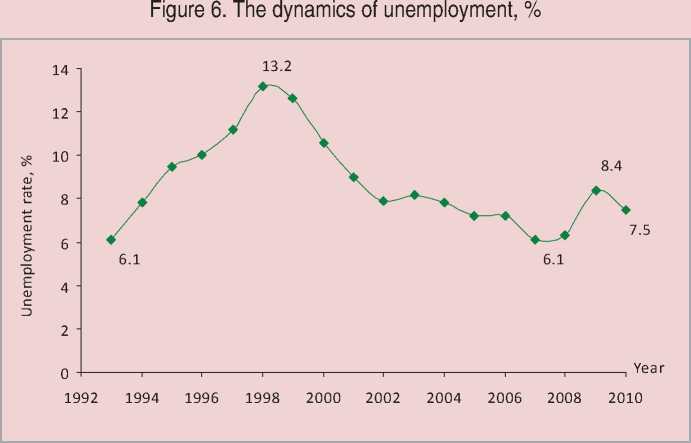
individuals or teams in crisis economic periods. The society was not involved in the distribution of significant property objects. At the beginning of perestroika, the most part of state property was divided among a limited number of persons; as a result about 15% of Russians owned 92% of national wealth [11].
At present, there is a fight for the opportunity to dispose the most important objects of property between the federal center, regional authorities and big business. You can see the diffusion of power in business, exclusion of an independent proprietor by the state-controlled owner in the Russian economy [3]. Property redistribution is being continued in the Russian industry. The largest banks of the country, natural monopolies and Federal subjects become the subjects of property. Regional authorities are trying to secure the legitimacy of their actions; some legislative acts that are passed by the Federal subjects contradict the Constitution of the Russian Federation and the Federal legislation.
On the other hand, entrepreneurs tend to be in power because they want to keep control of their business. The oligarchs are in power, at the same time, they control the appointments to key government posts.
The authorities do not strive for effective property rights, because in this case big business can be disaffected and their position will be precarious.
Thus, the property institution in Russia was formed as a result of a special type of the interaction between the government and business. Moreover, this interaction is based on different schemes – “white”, “grey” or “black”. “White” schemes are formed on the interaction only within the scope of the current juridical base. “Black” schemes involve the interaction within the scope of informal institutions, often in defiance of adopted legal norms. “Grey” schemes, which are the most common models in practice, include the informal interaction with the authorities in order to establish a special regime of legitimate business operation (lobbying their own interests, obtaining soft loans, exportimport quotas, etc.). The close cooperation with the authorities allows business to have a competitive advantage. Besides, there are mutual interests of businesses and authorities. Creating the favorable conditions for business allows the government to shift most direct obligations of social responsibility onto business, and it needs financial support [12].
The transformation of property institution can be divided into several stages. The access to property depended on the position in Soviet Government at the initial stage of the perestroika, so top government officials had full control over economic activity in the country. Then, the property institution began to change due to the transformation of the political system. There was an opportunity to organize a business outside the structures of the Soviet regime. The state officials privatized the part of the government property that was within their control and under the full control of state power.
The following phase coincided with the beginning of privatization and lasted until 1999. It was the most dramatic period in modern Russian history. The variability of the schemes for business organization increased during this period; the “grey” schemes of business organizations appeared. The contradictions between business and government intensified, their relationships worsened. Entrepreneurs tried to participate in governance in order to be independent in businesses organization. Business tended to be supported by the state for security enforcement. There was a beginning of corruption.
In 2000, after the change-over in the presidency, the government had the opportunity to form institutional environment for their own purposes, and its relationship with business began to be pragmatic.
Socio-political transformation . Russian society has undergone a series of radical sociopolitical changes over the last two decades. The public assessment of socio-political situation in the country has altered in accordance with these changes7. If less than 8% of the population assessed the political situation in the country as successful and peaceful at the beginning of the analyzed period, more than half the population took the same views in 2010 (fig. 7) .
There was a need to adapt the political consciousness to changing economic conditions due to the transition to a new economic management. There were the problems of transforming political culture at the level of an individual, social group and the state as a whole. Political culture reflects the political consciousness and values prevailing in society. The transformation of political culture leads to the change in basic values. Purposeless and irregular transformation of society leads to various political conflicts at the state, ethnic, national and other levels.
The process of socio-political transformation means the radical restructuring in all the spheres of social relations, especially political, that is accompanied by the natural transition from one socio-political system to another one with the change of ideological orientation and social, economic and political changes in a society.
The transformation of the political sphere in Russia is characterized by the quality renewal of the political elite and monocratic features of executive power. On the one hand, it led to establishing mass centrist party organizations; on the other hand, it promoted the growth of social and political apathy among large groups of people because it was not interested in effective activity within the political system. This resulted in a lack of alternative social and political programs. In addition, there was a lack of constant “value core” in the society. These processes are characterized as social and political crisis [5]. Social processes are dependent on the interests of some persons, who regulate the transformation of the Russian socio-political system, due to a lack of ideological and value bases.
There was no shared sense on the development prospects of the state at all the levels of vertical power structure at the beginning of perestroika; the opposition character of some social groups intensified and the crisis processes
Figure 7. Successful political situation in Russia, according to the population assessments
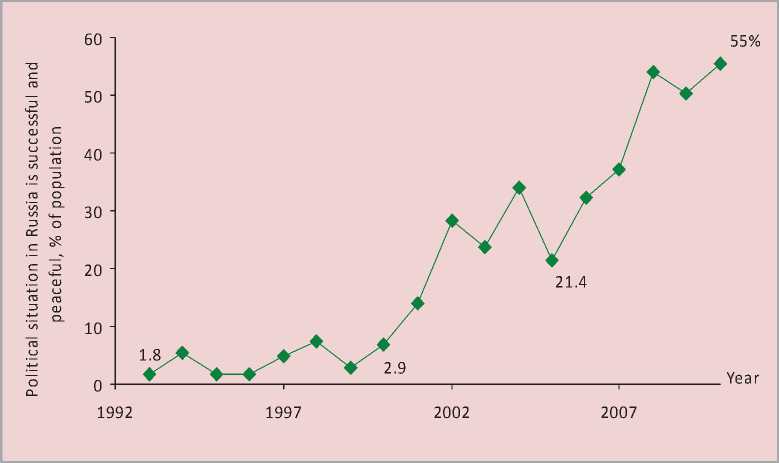
in power were aggravated. The absence of the middle class allowed the economic and political elites to regulate economic processes.
The systemic transformation of Russian society’s world outlook began in that period. The people, who dreamed of prosperity and democracy yesterday, thought about the ways to survive [4]. The impoverishment of people at large led to an increase in the number of marginalized groups, the spread of different types of deviant behavior, criminalization of interpersonal relationships, difficult interethnic relations. All this made it difficult to create the conditions for forming selfsustaining civil society and constitutional state. There was an increase in the number of non-legal actions and social tension.
The population differed in understanding democratic values. In 2001, 50.5% of respondents considered the positive role of democracy as a particular world-view vision, value requirements of which were the base of the following social and political processes in Russia, but only 6.1% of respondents thought that their role was positive [14].
The results of sociological surveys show that respondents’ views on democracy are different. Most respondents encourage democratic values verbally, but they put different meanings into the concept of democracy in different age groups. Young people focus on such values of democracy as freedom, human rights and personal independence. Citizen participation in governance and accountability close the list of values. The older respondents consider that responsibility and equality are more important for democracy [18].
Political parties, tracking their opinions of potential voters during the election campaign, pointed out the same values that unite a society: legality and order, stability, life of dignity, strong power, equality and justice. However, sociopolitical processes develop under the pressure of socio-economic and political contradictions. These contradictions cause the negative dynamic of socio-political system development, because the social and political institutions cannot work out the general programme on the base of common values for the majority of the population in order to join their efforts.
According to V.B. Iskhakov, the current developmental level of Russian society highlights the core values that have little impact on the socio-political processes in Russia. There is a predominance of two groups of values in the society united by the idea of stability, law and order. The society is tired of constant changes; it requires stability and social order.
However, this is necessary for some social, economic, and political groups for different purposes. The political and economic elite and state bureaucracy need stability to pursue a policy required by them and to establish stable relations in the economic sphere, where their relationship continues to be unstable. The power, which is represented by the President, is a source and guarantor of the stability of social relations for the society, so the voters, who are not interested in destabilizing the situation, casted their votes for the ongoing government policy. The most important values are the ideals implying the stability and social order, rather than the distant ideals of social and political world order [5].
These statements are confirmed by the results of a sociological poll conducted by the All-Russian Center for the Study of Public Opinion in the 2004. The concepts “order” and “stability” arouse positive feelings among 61% and 40% of respondents, respectively. For comparison, only 12% of respondents take the concept “socialism” as positive [6].
Declaration of stability and order as the fundamental values of social development influence the socio-political system that takes place in the transition period. It gradually acquires the characteristics of monocracy when the monopolistic power holders are the President and his political elite. The basic principles of monocracy are supported, in turn, by large and small socio-political groups.
Monocracy political governance during the transformation of socio-political system has its positive and negative sides. Positive effects include limiting the number of transformation regulators at the political level. The group of persons, who share common political, economic and other purposes, manages the transformation. However, this leads to negative consequences – to centrism. Centrism allows the political elite to maintain a stable position during the transition of social processes and to respond to public opinion, introducing the values, which enjoy the greatest support of the electorate, into their ideological construction [5].
The results of the poll that was conducted by the Russian Presidential Academy of National Economy and Public Administration in 2003, showed the great importance of the President in modern Russia. 66% of respondents, who answered the question “What do you think could help to solve your most exciting challenges of the current life in Russia?”, indicated strong political will and President’s power [9].
However, the socio-political system, which is characterized by the dependence of most things on some people, is not stable. Other political parties or groups will try to use force and pressure to achieve power and control. It is dangerous to be out of power in such a society.
Timeless, structural and peripheral values can also cause conflict situations. Timeless values that are in our subconsciousness (sociocultural, religious, etc.) are considered to be controversial throughout the history of mankind, because they are objective basis for most spheres of society. Structural and peripheral values are caused by the specific features of a particular socio-political system. They include all the principles, rules and regulations that serve as the foundation of the relationship between people, groups and nations within a single state. The dominance of purely national values in the social processes is felt by the ethnic minorities that have the status of political autonomies in Russia [5, 16].
Thus, there are some specifics in the sociopolitical transformation of Russian society. There are no historical analogies of the current changes, because they correspond to the inverse developmental model of socio-political system in the absence of a clear return policy to a stable state.
Socio-economic changes were dramatic for the economy and very painful for the society. Unskillful activity of reformers in the rash transition of a centralized state economy to a market economy led to the decline of key industries and caused discontent in the society. The rapid impoverishment of large social groups gave rise to social tension and fear, because most people did not understand the long-run objectives of their hardships. The people gradually lost their interests in the political processes, so they allowed the ruling elite to regulate the political and economic processes according to its own schemes. However, the society needs clear guidelines, which will contribute to achieving social, economic and political well-being of Russia.
The transformation of population mentality in Russia
Due to the transformation of ownership forms and changes in socio-political environment, socio-cultural conditions for people’s living have changed, social inequality have become more acute and new social groups have emerged (entrepreneurs, freelancers, unemployed, etc.). All these changes have required the evolution of population mentality that is transformed more slowly than economic reality.
In this case, mentality is understood as a set of social and psychological attitudes that are inherent in the way of living in the country, mind habits, the ways of seeing the world, the views of people, who belong to any sociocultural and ethnic communities, the way of thinking, which is based on a value system [1]. The mentality is formed in the process of obtaining education and life experience.
There is a personal mentality, group and national mentality with the predominance of collective mentality over personal one. Experts identify different types of national mentality: political, economic, social, ethnic, religious, etc. National mentality integrates the mentality of some strata and social groups within the nation state.
When the value system changes (their set or hierarchy), the mentality of total population and its social groups also changes. Transition periods in the socio-economic life of society are accompanied by the instability of social consciousness.
Sociological researches that were conducted at the end of the Soviet period identified the following priority values of the Russians: benevolent attitude, independence, creativity, sustainable future and good income. They were followed by such values as the respect for people, public benefit, debt to the state, nonhard working and professional development. These values characterized the stable Soviet society in the late Soviet period [8].
Economic transformations were accompanied by the changes in the awareness of social guidelines. The core values began to transform significantly already in the late Soviet period: so, labour was declared as the main value for a builder of communism, but the living standards of people depended slightly on their labour input. The values of socialist ideology were gradually displaced and substituted with new ones.
Traditional values were changed into the crisis forms of mentality during the transitional period. Many Russians had a feeling of void, loneliness, abandonment and frustration; they craved for inner life and integrity. The people did not feel immune from the new conditions in the country, facing the challenges of development; they had social fears and the sense of social insecurity. These feelings were caused by the structural collapse of the existing Russian mentality and the loss of social guidelines.
The Soviet-era values and guidelines that were the base of the Soviet mentality began to be denied. New Russian mentality with a new value structure was created; the ways and forms of reality understanding changed. The significance of self-sacrifice values reduced; there was a decrease in the traditional distribution of the values of freedom, independence and initiative. There was a beginning of such new features as the adoption of competition. There was a return to traditional values (family, health, material well-being).
Values link a man to a social system. There are several value systems in the modern Russian society (traditional, transitional and innovation), that form the appropriate mentality. Some of them are oriented to the common, collectivist forms of life, and others are aimed at the separate and individualistic forms.
The traditional mentality involves the adherence to the traditions; its values are regulated more tightly. Traditional mentality also prefers the “equality in poverty” rather than “inequality in wealth”; it waits for the paternal care of the state, a special attitude to the Russian statehood. The important components of Russian culture are also legal nihilism, public piety, self-restriction of political freedom and a sense of political responsibility. Innovative mentality involves less private relationships, active position in life, rationality and focus on personal achievements. The values of innovative mentality allow the collective subjects to have more freedom in life. There are no clear value orientations in transitional mentality; the image of the world is more chaotic and threatening, people hesitate in their choices [7, 10, 17].
Social researches of value components of the Russian mentality [7, 8, 15] prove that a man and a collective subject choose the new social values for self-determination, social roles, positions for identification; they focus on the new social and psychological qualities that are demanded by changing socio-economic conditions. There is a process of partial transformation of collective subject’s mentality. At the same time, the base values don’t change. Traditional values of health, family and work remain stable, but the meaningful content of these values differs a little bit from the traditional one.
Traditional mentality links the health to active lifestyle and sports. Currently, the leading value “health” does not combine with a healthy lifestyle. 60% of respondents associate the word “health” with the word “pills”. The advertising of medicinal drugs stands this in bad stead.
Despite family values are priority, they have been also significantly transformed: their meaning and the programme of family relationships have been changed. Today’s family includes the development of both spouses; both parents strive for personal growth, they distance themselves from each other. There is no such prerequisite as marriage registration for founding a family. “One common family purse” is replaced by the division of material incomes.
The value of “work” was traditionally linked to the value of “public benefit” in the professional field. Today, the purpose of work consists in achieving the personal financial well-being. There is a predominance of private purposes over public ones. There is a desire for “easy” money earned often due to unfair labour. There is a decrease in general professional education with an increase in ambition and low social competence. The change in the meaning of work has caused the changes in its value. The word “labour” is not associated with socially useful work but with incomes.
Friendly relations have become similar to friendship that is based on business utility rather than on personal sympathy. Relationships have become more distanced. The number of friends and time of meetings have been reduced.
Press, radio, television and the Internet are also the important tools to change the mentality of modern society. The Internet has increased the volume of information received; it has decreased the time of finding it. Information has become more accessible.
According to the recent polls, the priority values include the values of safety, health, family and paid work, and the problems of survival are in the first place.
The mentality transformation has caused a wide value gaps between young people and adults. The older generation has the traditional mentality, collectivism is inherent in it, and young people are characterized by individualism. The younger generation is ready to change, young people want to be active and mobile, and therefore, they are gradually losing the Russian mentality and acquiring the crisis mentality. Life goals of young people remain within their traditional values – education, work and family. Besides, career, material wellbeing and well-paid jobs, i.e. the material side of life, have become more important. Today young people focus on their own resources in solving problems. The general trend is an increase in the importance of personal values in comparison with the public ones [13].
Population mentality does not only unite the people, but it divides people into different groups, including ethnic ones. The most important feature of ethnic mentality is a growth of ethnic consciousness and simultaneous rupture of Russian national and cultural traditions. According to experts, domestic national wars on Russia’s borders are defined as “the growth of ethnicity”.
Thus, there are significant changes in the mentality of the Russians that reflect the failure of communist ideology, change of social status and social role of most people, while maintaining traditional values. You can see striving for a unifying national idea, which is valuable for most Russians.
Список литературы Socio-economic transformation of Russian society
- Andreyeva E.A. On the concept of mentality in modern Russia. Available at: http://sib-subethnos.narod.ru/p2005/andreeva1.htm
- Bessonova O.E. Distributing economy of Russia: evolution through transformation. Moscow: ROSSPEN, 2006.
- Gubar O.V. National features of property transformation. Bulletin of the Academy. 2001. No. 1. Available at: http://профессор-экономики.рф/index.php
- Zelenko B.I. Parties and elections in Russia. Moscow: Modern Economics and Law, 2003.
- Iskhakov V.B. Socio-political transformation in Russia at the turn of the century: socio-political aspects. Problems of national strategy. 2010. No. 1 (2).
- Our thoughts in 2004: Russia at a crossroads. Moscow: Eksmo, Algorithm, 2005.
- Karpova Yu.A. Introduction to the sociology of innovation. St. Petersburg: Piter, 2004.
- Lapin N.I., Belyaeva L.A., Naumova N.F., Zdravomyslov A.G. Values dynamics of the population in reforming Russia. Moscow: Editorial URSS, 1996.
- Ledyayev V.G. Sociology of power: conceptual issues. In: The Power and the elite in today's Russia. Ed. by A.V Duka. St. Petersburg, 2003.
- Lubskiy A.V. Russia as a civilization. Chronos web site. World history of the Internet. Available at: http://www.hrono.ru/statii/2003
- Lvov D.S. Economics is looking for its face. Economic Review. 2002. No. 5.
- Maryin-Ostrovskiy A.N. Transformation of property institution in Russia. In: Transformation of political and social institutions in today's Russia. Col. art. of postgraduate students of the Department on applied political science and sociology of SU-HSE. Moscow: High School of Economics, 2008.
- Young people of new Russia: life and value priorities. Analytical report. Moscow: Institute of Sociology, 2007.
- Petukhov V.V. Political activity and civic self-organization of the Russians. Social Sciences and the Present. 2002. No. 6.
- Pischik V.I. Transformation of values and meanings components of population's mentality of the South of Russia. Voprosy Psychologii. 2008. No. 3.
- Semenov V.S. Russia in conflict network. Voprosy Psychologii. 1993. No. 7.
- Sikevich Z.V. Russian self-consciousness in the early XXI century. In: Russian mentality and challenges. Russian Geographical Society. St. Petersburg, 2011.
- Shestopal E.B. Prospects for democracy in the minds of the Russians. Social Sciences and the Present. 1996. No. 2.
- The database of the Statistical Division of UNECE//http://w3.unece.org/pxweb/?lang=14
- Official website of the Federal State Statistics Service//www.gks.ru


